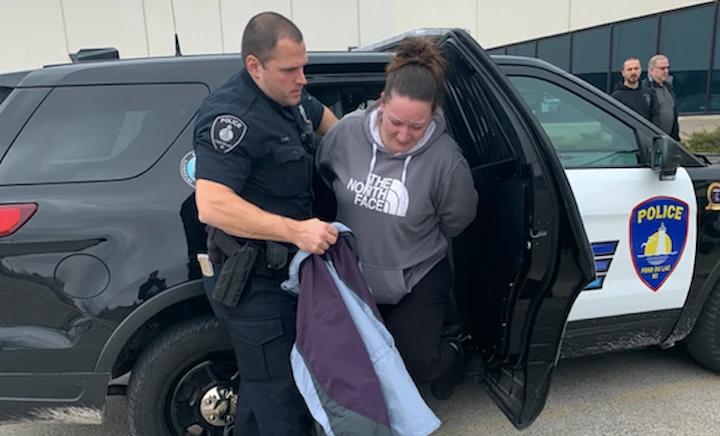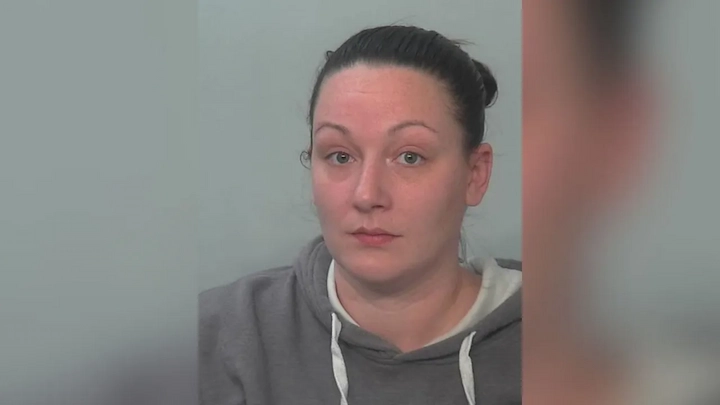Cold Case Solved: Stacy DeGrandchamp Murder Mystery Ends with Friend’s Confession After 17 Years
For nearly 20 years, the 2002 murder of 17-year-old Stacy DeGrandchamp went unsolved — until her former friend Holly Boisvert confessed to the crime. This article follows the story of how one common teenage argument escalated into a fatal stabbing that killed Stacy in Fort Wayne, Indiana.
The case turned cold for years as authorities grappled with gathering physical evidence against the suspected murderer, despite numerous witnesses at the scene. The article recounts the original investigation, the reopening of the case in 2019, Boisvert’s stunning confession, and her sentencing in 2022.
This story also reminds us that law enforcement and family members don’t always give up on finding justice for the victims. Cold cases sometimes can be solved decades later with persistence and fresh investigative tactics.
The resolution provides closure to a mourning family, but also shows, too, how issues involving teenage egos can spin so tragically out of control with consequences for someone’s lifetime.
A Promising Life Cut Short
Stacy Maria DeGrandchamp was born on Oct. 29, 1984, to Rita K. DeGrandchamp, who made her daughter the center of her world. In Fort Wayne, Indiana, where she was raised, Stacy was surrounded by a large, close-knit family of aunts and uncles and an astonishing 27 cousins with whom she felt a deep, meaningful connection.
A true empath, she opened her heart to help anyone suffering. She attended Wayne High School, where she did well academically and had plans for the future. She had already applied to Ball State University, planning to major in computer programming.
She attended St. Therese Catholic Church and was active there. Stacy was very social and well-liked and had a large group of friends. She had been dating Brandon Muff, then 20, but at 17, she chose to break things off as she neared graduation with an eye toward the opportunities ahead. It began as a typical summer night with friends on August 15, 2002, resulting in a tragedy that would alter several lives forever.
The Night Everything Changed
What started as a meeting at a friend’s Fort Wayne home rapidly became fatal. Holly Boisvert was already at home when Stacy arrived on Guthrie Street. The tension between the two former friends had been brewing for quite a while, mainly because Holly once dated Stacy’s ex, Brandon Muff.
Witness statements indicated that several hours before Stacey arrived, Boisvert had changed into sweatpants and put her hair up, as she seemed to be getting ready for a fight. One witness said Boisvert told him DeGrandchamp was “going to take an [expletive] whipping tonight.”
Stacy noticed Holly’s presence and commented on it when Brandon came to the residence. That escalated quickly into a heated debate between the two young women. Witnesses at the scene said the argument quickly escalated into a physical confrontation, with both teenagers wrestling on the ground and pulling each other’s hair.
Stacy walked away a few steps, then fell suddenly to the driveway after her friends and family got her away. That’s when people started seeing the suspicious bloodstain spreading on her shirt. But, she died the following day, August 16, 2002, despite being rushed to the hospital.
Aftermath Timeline: Tracing Origins As Initial Investigation Hits Roadblocks
Upon arriving on the scene, police found Holly seated on the porch. In her first interview, she said she had not used a knife on Stacy. Instead, she suggested that DeGrandchamp could have fallen on something sharp when she was shoved into some recycling bins during the scuffle.
But the results of the autopsy told a different tale. Stacy had suffered two separate stab wounds that would not be consistent with a fall in a drunken stupor. But lacking a murder weapon and with no clear eyewitness account of the act of stabbing, investigators had an uphill battle to make the case.
In January 2003, a key witness stepped forward. A few days after the stabbing, Boisvert confided that she did carry a knife toward her attacker, they said. The witness also said that after the fight, Holly had washed her hands and put a knife on or near a car that was parked in front of the house.
Despite the new testimony, the knife was never found at the time, and without physical evidence connecting Boisvert to the stabbing, the case eventually went cold. But the determination by Stacy’s family kept fighting against the drum line of their loved one.
Breaking The Case Open
(According to the detective, his family had previously declined to provide a sample.) In 2019, almost 17 years after DeGrandchamp died, Fort Wayne homicide detective Brian Martin reopened DeGrandchamp’s cold case based on new evidence provided by Stacy’s family. The reinvestigation included reviewing evidence, performing forensic tests, and reinterviewing witnesses in several states.
The breakthrough in the case came when detectives questioned Boisvert, now 33, at her home in Fond du Lac, Wis. With tears running down her cheeks, she made a startling admission: “I think I killed my best friend.”
A pocket knife Boisvert turned over to investigators during that interview was the weapon she had used in 2002, she said. “If I had just walked away and didn’t turn around to fight, Stacy DeGrandchamp would still be alive,” she said.
And the knife would ultimately give the investigators the crucial evidence they needed to solve the case: A pathologist, examining the original crime scene photos, DeGrandchamp’s autopsy photos, and the knife, determined the knife was consistent with the murder weapon and matched Stacy’s wounds.
Justice At Last
In March 2020, police arrested Holly Boisvert in Fond du Lac, Wisconsin, and extradited her to Indiana to face murder charges. The arrest followed a yearlong reinvestigation and greatly relieved Stacy’s family. “To receive that phone call, to hear the detective say that ’We got her,’ it’s just an amazing, fantastic feeling,” Jamie McMillen, Stacy’s cousin, said in a local media interview.
Initially charged with murder — which can result in a 65-year sentence in Indiana — Boisvert pleaded guilty to the lesser charge of voluntary manslaughter in December 2021. On Jan. 14, 2022, almost 20 years after the crime, she was sentenced to 25 years, with five years suspended and three years of adult probation.
When Boisvert appeared for sentencing, she told the court: “I would like to apologize, I’m sorry.” She is now 38 and is incarcerated at the Indiana Women’s Prison in Indianapolis, with a scheduled release date of March 25, 2030.
The Impact On Families
Stacy’s sister, Jamie McMillen, spoke in court during the sentencing, describing the deep pain her family had endured during the 19 years after her loss. “I didn’t know if we would ever see this day,” she said. “We keep pushing harder and, thank God we had a good detective on the case and we could pick it up and roll with it.”
For Stacy’s family, the plea and sentencing offered long sought closure. “We’ve waited many years to hear her say she did it. And her signing the plea deal was the first place that she was willing to sign off and say, yes, I did do it,” McMillen explained.
The case is a stark reminder of how adolescent squabbles can have tragic, life-changing repercussions. What started as weariness between friends ended with one young woman dead and the other behind bars for years, altering the courses of two families.
FAQ
Q: What was the length of time to solve Stacy DeGrandchamp’s murder?
A: The case went unsolved for about 17 years — from August 2002 until Holly Boisvert confessed in 2019.
Q: What was Stacy DeGrandchamp’s relationship with Holly Boisvert?
A: They had been close friends and had been in the same social circle, but their friendship had been strained, in part because the two of them had dated the same boy, Brandon Muff.
Q: How did you make progress in this cold case?
A: Why was this case reopened in 2019? Detectives interviewed witnesses a second time and ultimately obtained a confession from Holly Boisvert, who also turned over the knife that was used in the crime.
Q: How long was Holly Boisvert’s sentence?
A: Boisvert was sentenced to 25 years with five years suspended and three years on adult probation after pleading guilty to voluntary manslaughter. She is projected to be released on March 25, 2030.
Q: Why didn’t Holly Boisvert get convicted right after the murder?
A: The first investigation was bereft of physical evidence, even though there was eyewitness testimony. The weapon wasn’t recovered, and with no conclusive evidence to connect Boisvert to the stabbing, authorities weren’t able to mount a strong enough case.
Final Words
The resolution of the murder case against Stacy DeGrandchamp shows that sometimes, it just takes persistence to achieve justice, even as leads go cold. Her family kept her memory alive and never gave up fighting for answers for nearly two decades. Determined and thorough detective work ultimately led to the confession that brought a purposeful close to this heartbreaking story.
This case is also a sobering reminder of how quickly teenage quarrels can spiral with deadly results. What started as feuding between former friends ended with one promising young life snuffed out and another forever stained by a terrible choice made in a moment of rage.
As Detective Brian Martin’s successful reopening of this cold case demonstrates, advances in forensic technology and investigative techniques mean that cases previously written off as unsolvable can sometimes find resolution many years later.
For families still seeking answers about loved ones killed in violence, Stacy’s story represents both hope that justice is possible and a sign of the enduring value of a family’s love and determination to remember their lost loved one.
Table of Contents



